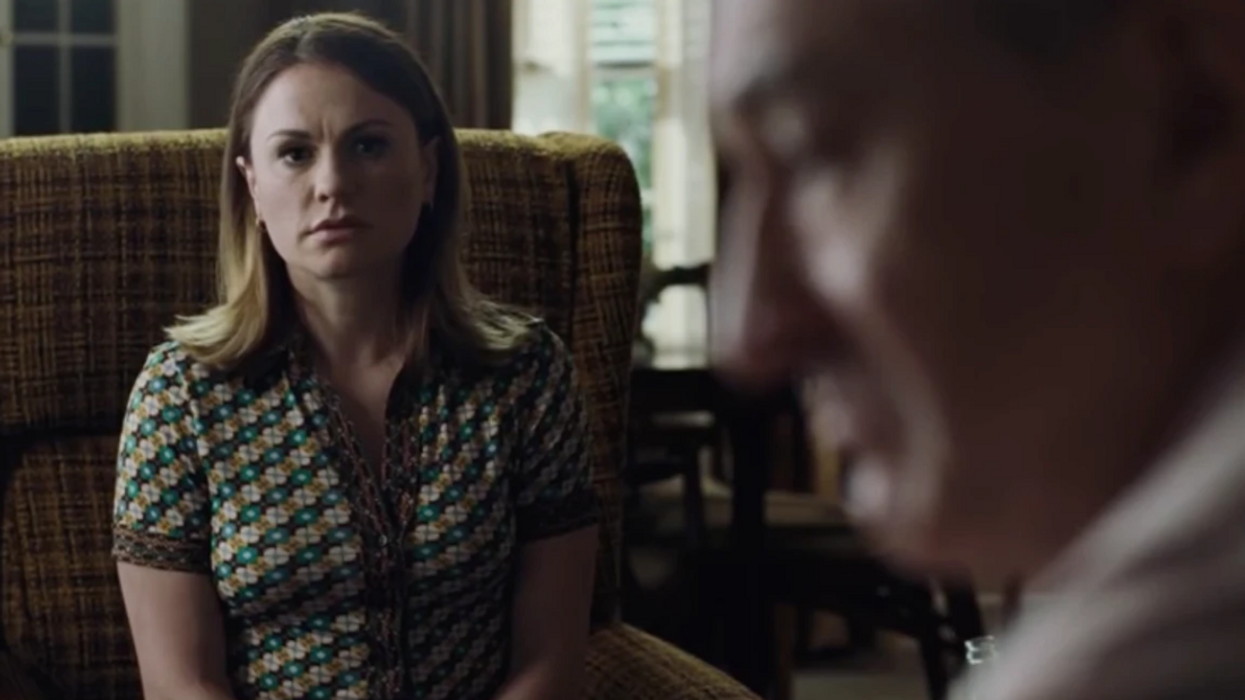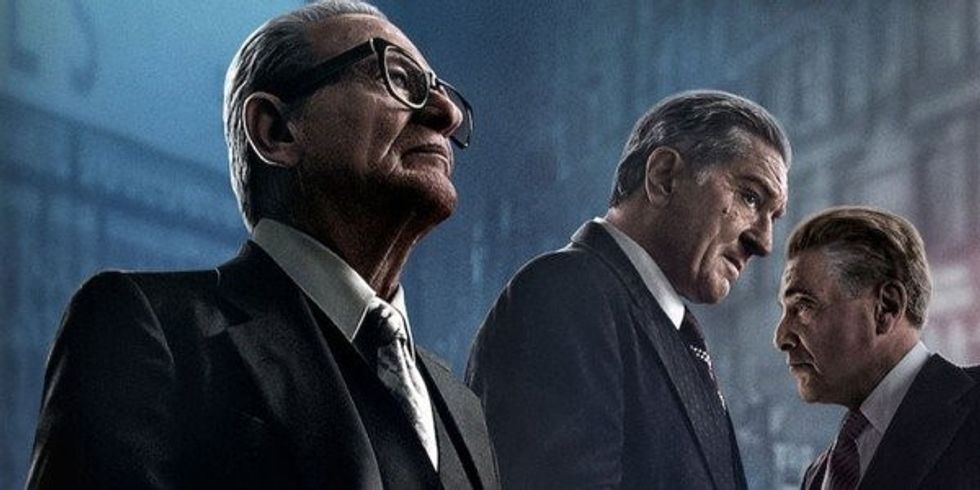That One Astonishing Scene in 'The Irishman' Explained
The Irishman is an epic, and we'll look at how one specific moment is executed perfectly.

Martin Scorsese's The Irishman is streaming on Netflix this week, and soon everyone will have a chance to watch it. There is a lot to unpack in this movie; it's made by one of the greatest filmmakers of all time and stars many of his greatest collaborators.
But there is ONE part that must be discussed and is emblematic of the power of cinema as an art form. We're going to talk about this moment, the genius of the artists who crafted it, how it comes together so perfectly, and what it teaches us as filmmakers.
Because whatever you think about The Irishman on the whole, there is simply no denying that this particular moment is filmmaking at it's finest.
The filmmaking problem of infinite choices
The genius of the moment is in its execution and the build to it over the course of the entire film. And we'll get to all of that.
But first, we have to mention how pulling something like this off is so incredibly challenging and rare.
We often think about filmmaking in terms of limited resources. Time and money being the primary limiting factors. Even with a roughly 150 million total budget, we know that shooting The Irishman was an immense challenge. It ran it's cast and crew ragged and pushed them to the brink.
But this is so often the case in production.
Yet despite the fact that projects always need more time and money, there is something else almost all projects have an infinite supply of.
What is it?
Decisions.
One decision that often overwhelms and hamstrings people is a simple one.
Think about how that question can unfurl into a paralyzing set of many more decisions. Where should it be for each shot? How should they all cut together?
A filmmaker gets a sense of how movies are put together and then follows a rhythm. But throughout any sequence, these choices multiply. Costumes, lighting, set dressing, the whole canvas.
So when we talk about what a director is faced with when putting together a supremely important moment we have to consider how many options were available to them.
Why did Martin Scorsese choose to shoot this moment the way he did? Let's consider it by looking at how the entire epic built to it.
Building to the Scene
If you haven't watched the film, now would be a good time to go watch it and come back 4 hours later.
In other words: spoiler alert.
The Irishman is the story of a mob hitman reflecting on his life, but in particular, remembering a couple of days in his life where he did something he can never forgive himself for.
Along the way we get flashbacks within flashbacks, all meant to craft an elaborate tapestry that makes up the mafia in the mid-20th century.
Robert De Niro plays hitman Frank Sheeran, and his relationship with mob boss Russell Bufalino (Joe Pesci) and Labor Union President Jimmy Hoffa form the love triangle at the heart of the movie.
And make no mistake; this movie is about bromances. Deep ones, that supersede any relationships the men have with any women. These men are brothers at arms. The women in their lives barely speak to them, mostly speaking to each other in the visual and auditory background.
Consider this: there are scenes of these men going to bed together, albeit in separate beds, and declaring their needs and support for one another. There is nothing even approaching that between them and any female characters.
The bond between Frank and Russell runs deep, as does the bond between Frank and Hoffa. In the end, Frank is forced to choose, but it hardly feels like a choice at all.
In the middle of it is Frank's eldest daughter. We see the three men and their relationships through her. Scorsese's camera focuses on her gaze. When she watches her father abuse a shop-keeper who gave her a hard time, and when we watch her watching him befriend Jimmy Hoffa. The running touchstone here is that his daughter adores Jimmy, and is fearful of Russell.
There could be a deep analysis just on this alone. But for the purposes of the scene in question, and the genius behind it, we need to understand how carefully woven into this epic story Frank's daughter's gaze is.
There is a male gaze, and a female gaze... this is certainly a child's gaze.
You wouldn't KNOW as you go through the film viewing it how important this piece is. But it's placement is critical to the movie. Her gaze is constantly recognized by Frank. He sees it; it cuts to his core.
But the movie's drama and plot have nothing to do with this repeated visual.
That is... until...
The Unsolved Mystery
The Irishman is a movie that tells a version of one of history's great unsolved mysteries: what happened to Jimmy Hoffa.
There was a time, not all that long ago, where this was a question that obsessed parts of society. One of the most famous known figures disappeared. Who killed him? Why? Where is he?
Charles Brandt's book "I Heard You Paint Houses" is Sheeran's version of what happened to Jimmy Hoffa. The Irishman is based on this book and as we find ourselves closing in on the final moments we know before it happens what Sheeran's claim is.
That he killed Hoffa.
The movie foreshadows this event and spends many scenes where characters warn Hoffa. You can see it coming a mile away. Because Scorsese knew that this wasn't the explosive element at the core of his story.
Just as we wrote about how Quentin Tarantino toyed with actual historical events in his masterful epic this year, Once Upon a Time in Hollywood, we find ourselves on similar ground.
Scorsese can't surprise you with what happened to Jimmy Hoffa, and even if he could he doesn't care to.
Unlike Tarantino, he won't surprise you by writing a new chapter in history and changing events.
Scorsese instead decides to aim his camera unflinchingly at the humanity within it, giving us something very unique in the mafia genre.
"Why didn't you call already?"
The moment where Frank shoots Jimmy is unremarkable. It happens in a wide shot, two quick bullets, Jimmy is down and that's the end of that.
Most of the assassinations committed in the movie have a sudden blunt nature to them. They are unromantic and a bit cowardly by cinematic standards. The hitman walks by, he pulls his gun out, shoots fast, and runs away.
There is no quick draw cowboy stuff. There is no "say hello to my little friend." There is no, to take from Scorsese's earlier works, brutality like heads in vices, or "go get your fuckin' shine box" retaliations.
It's a hit and run every time.
Hoffa's murder is no different.
When it's been a few days since Hoffa went missing, and it's all over the news, Frank and his family watch the TV in horror. The Hoffa's were close family friends. Jimmy and Frank were brothers. Frank's daughter's horrified gaze shifts from the TV over to Frank when he mentions that he should call Jimmy's wife.
That's when her gaze throughout the film reaches it's most powerful. She sees right through him. Without having uttered more than 3 lines of dialogue in the entire 3 hour plus movie, a visual motif about visuals... pays off.
We can tell that Frank can tell that she can tell that Frank had something to do with this.
It's our little awful secret. The audience, Frank, and his daughter.
She asks why Frank hasn't called yet. She knows why. We know why. Frank knows why.
And that's all that happens to take us to this scene.
Frank goes upstairs and sits down with the phone to call Jimmy Hoffa's wife Jo and console her... reassure her... about how her husband and his dear friend has vanished.
But the cinematic genius NOW is that Scorsese hands the reigns over to his longtime onscreen muse and counterpart.
Robert De Niro delivers a performance in this moment that captures something so dark, deep, and horrible and impossible to relate to. Yet... there it is onscreen. You'll never doubt for a moment that it is honest in its depiction.
De Niro's Sheeran stutters and stumbles through consolation, and once again you can almost tell that Jo Hoffa (Welker White) knows what happened. She tries to ask Frank. Frank tries to answer. They dance awkwardly around the unsayable and the unthinkable, mainly in false starts and silence.
It's something to behold.
This moment was crafted and earned through minimal dialogue, and mostly silent visual storytelling over the course of an entire feature film.
The lesson
Great stories can be about simple moments. Powerful visuals can be nothing more than a human's face. While The Irishman relies on a hugely expensive de-aging process to allow De Niro, Pesci, Pacino, and others to play these roles at various ages... none of that matters when it comes to what makes the moment a transcendent example of what movies can do.
They can show you sides of the human experience you'd never imagined. They can put you in the moment with someone as they grapple with a life-altering and horrible choice they felt they had no choice about. As De Niro's Sheeran later utters to himself in his old age home when he is alone and forgotten, "what kind of man makes that call? What kind of man makes that call?"
The character is haunted by his Cain and Abel level transgression. But the audience and filmmakers alike may be haunted by something else. That scenes and moments like this, so achievable with the basic building blocks of any visual story, are so incredibly hard to come by.
Let this scene, and Scorsese inspire you to craft these kinds of moments. Cinema needs them and it needs you.
















